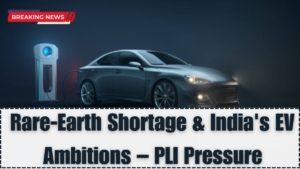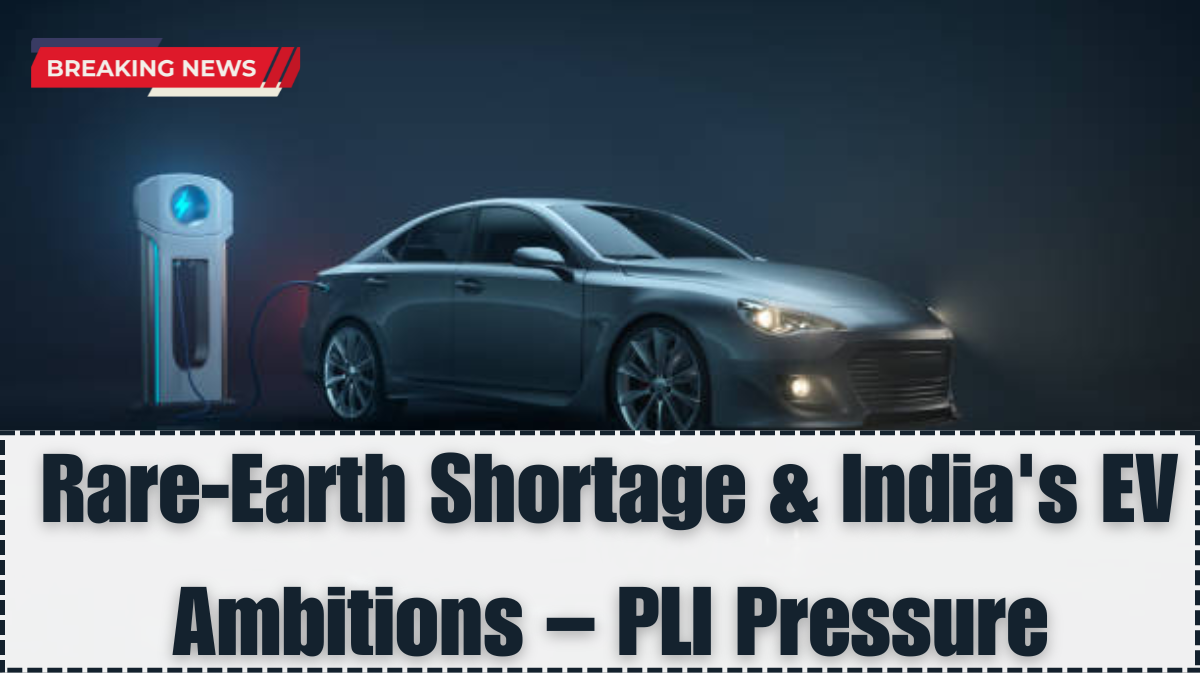India’s electric vehicle expansion is facing a critical challenge in 2025: the global EV magnet shortage triggered by China’s tightening control over rare-earth exports. These materials — such as neodymium, praseodymium, and dysprosium — are crucial for manufacturing high-performance magnets used in EV motors. With China’s recent export restrictions, India’s EV plans under the Production Linked Incentive (PLI) scheme are under strain.
The EV supply chain is feeling the heat. Automakers, motor manufacturers, and component suppliers are scrambling to find alternative sources, as domestic production of rare earths remains limited. This shortage not only risks production delays but also threatens India’s broader clean mobility targets.

Why Rare Earths Matter in EV Manufacturing
Rare-earth elements are the building blocks of permanent magnets, which power the electric motors found in two-wheelers, cars, and even commercial EVs. These magnets are preferred for their high torque-to-weight ratio, thermal stability, and energy efficiency.
Critical EV applications include:
-
Traction motors in electric cars and scooters
-
Battery Management Systems (BMS) and inverters
-
DC-DC converters and power steering systems
-
Magnetic sensors for drivetrain control
The current EV magnet shortage is causing price surges, procurement bottlenecks, and increased lead times for Indian manufacturers, affecting both local production and exports.
China’s Export Limits and Global Impact
China currently supplies over 85% of the world’s rare-earth magnets, and its decision to restrict exports in early 2025 has sent shockwaves across the global auto industry. The move is part of a broader strategy to prioritize domestic industries and limit outflows of strategic resources.
Impact on India:
-
15–25% cost increase in imported rare-earth components
-
Production slowdowns in premium EV segments
-
Delayed compliance with PLI milestones
-
Urgent need for supply chain diversification
The ripple effect of this EV magnet shortage is visible in slowed output from leading players and postponed EV launches originally scheduled for H1 2025.
How It Affects India’s PLI-Driven EV Targets
The Indian government launched the PLI scheme to incentivize local manufacturing of EVs and advanced automotive components. However, rare-earth material dependency is becoming a roadblock for companies looking to meet minimum value addition and localization norms.
| PLI Segment | Affected Components | Status |
|---|---|---|
| EV Motor Manufacturing | Permanent magnets, rotor cores | Delayed |
| Battery & Cell Production | Anodes using rare-earth metals | Price Hike |
| Power Electronics | Magnet-based sensor systems | Delayed |
Unless India finds alternatives or develops local supply quickly, this EV supply chain disruption may hinder incentive eligibility for multiple players.
Possible Solutions and Government Response
Recognizing the crisis, the Indian government is exploring multiple solutions to mitigate the impact of the EV magnet shortage:
-
Fast-tracking mining projects in Andhra Pradesh and Rajasthan
-
Bilateral talks with Vietnam and Australia for rare-earth imports
-
R&D incentives for alternative motor tech (e.g., ferrite magnets)
-
Encouraging closed-loop recycling of EV components
-
Inviting private-sector FDI into rare-earth processing units
These steps are essential to protect the momentum of India’s EV mission and reduce long-term reliance on a single global supplier.
FAQs
Why are rare-earth materials important for EVs?
They are used to make permanent magnets for EV motors, ensuring high power density, thermal stability, and efficient performance.
What caused the current EV magnet shortage?
China, the world’s largest supplier, imposed export restrictions in 2025, reducing global availability and increasing prices.
How is the shortage affecting India’s EV industry?
It has led to delays in EV production, rising costs for component manufacturers, and difficulties meeting PLI scheme criteria.
Is India self-reliant in rare-earth production?
Currently, India lacks large-scale rare-earth mining and processing infrastructure but is working on developing it through new policies.
What are the alternatives to rare-earth magnets in EVs?
Alternatives include ferrite magnets, induction motors, and newer technologies like switched reluctance motors, though they are still in early-stage development.
Click here to know more.
Aanchal is a passionate writer with a keen interest in storytelling, content creation, and creative expression. She enjoys exploring diverse topics and crafting engaging narratives that captivate readers.
